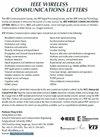近场传感:一种低复杂度的波数域定位方法
IF 5.5
3区 计算机科学
Q1 COMPUTER SCIENCE, INFORMATION SYSTEMS
引用次数: 0
摘要
提出了一种低复杂度的近场传感波数域定位方法。具体来说,在波数域中,功率集中区域是稀疏的,并且与目标的位置密切相关。然而,这种关系是复杂而隐含的。为了解决这个问题,采用双向卷积神经网络(BiCNN)架构来捕获潜在的关系,实现低复杂度、无网格的目标定位。仿真结果表明,与现有的网格上多信号分类(MUSIC)算法相比,BiCNN方法在获得较高准确率的同时显著降低了计算复杂度。本文章由计算机程序翻译,如有差异,请以英文原文为准。
Near-Field Sensing: A Low-Complexity Wavenumber-Domain Positioning Method
A low-complexity wavenumber-domain positioning method is proposed for near-field sensing. Specifically, in the wavenumber domain, the power-concentrated region is sparse and closely related to the target’s position. However, this relationship is complex and implicit. To address this, a bi-directional convolutional neural network (BiCNN) architecture is employed to capture the underlying relationship, enabling low-complexity, gridless target positioning. The simulation results reveal that the BiCNN method significantly reduces the computational complexity compared to the existing on-grid multiple signal classification (MUSIC) algorithm while achieving high accuracy.
求助全文
通过发布文献求助,成功后即可免费获取论文全文。
去求助
来源期刊

IEEE Wireless Communications Letters
Engineering-Electrical and Electronic Engineering
CiteScore
12.30
自引率
6.30%
发文量
481
期刊介绍:
IEEE Wireless Communications Letters publishes short papers in a rapid publication cycle on advances in the state-of-the-art of wireless communications. Both theoretical contributions (including new techniques, concepts, and analyses) and practical contributions (including system experiments and prototypes, and new applications) are encouraged. This journal focuses on the physical layer and the link layer of wireless communication systems.
 求助内容:
求助内容: 应助结果提醒方式:
应助结果提醒方式:


